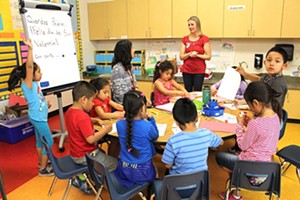Miles Restrepo was intensely focused on coloring a picture, so when I interrupted him with a question about how he likes his kindergarten class, he wasn’t exactly thrilled.
“I love it so much,” he said. “The end.”
He returned to his coloring for a moment until I tacked on another question: Why does he love it?

He smiled shyly: “Because we learn so much, and I’m not telling you any more.”
He turned and walked off to join his friends, who were showing off their own drawings and chattering in Spanish. Miles was right: He and his classmates do get to learn a lot in class, compared to most kindergarteners.
Miles is one of 59 students in Roberto Jiménez Elementary School’s dual language immersion kindergarten class, a bilingual, biliteracy program and the first of its kind for the Santa Maria-Bonita School District. February marks the halfway point for Jiménez Elementary’s inaugural school year, and according to Principal Richard Ruiz, the dual language immersion program is a hit.
“We have our English-only kids who are now speaking Spanish, and we have our English learners who continue to speak Spanish and master the Spanish language,” Ruiz said. “It’s a wonderful opportunity for all kids, and it’s going very well.”
The district’s board of education unanimously approved the dual language immersion program a year ago, and now Jiménez Elementary is preparing to continue and expand the program for next year.
“We’re out recruiting,” Ruiz said. “We want parents to come in and hear what we have to offer to them and hear what a dual language program is and what it’s not. It’s not your old bilingual program. It’s an inclusive program.”
Jiménez Elementary has adopted the 90-10 dual language immersion model, meaning 90 percent of its kindergarten classes are taught in the target language—in this case Spanish—and the other 10 percent are taught in English, which for the Jiménez kinder classes adds up to only about 20 minutes each day.
Carlos Pagan, director of literacy and language support for the Santa Barbara County Education Office, said that by fourth or fifth grade the classes will be half Spanish and half English.
Dual language immersion differs from typical foreign language courses because it surrounds its students with the target language most of the time from a young age. Otherwise, the curriculum is the same as any other kindergarten class. Typical language programs, on the other hand, allocate about an hour a day for lessons on the target language.
“They don’t produce students that are really bilingual and biliterate,” Pagan said. “It’s when you’re in an immersed environment that you produce native-like proficiency in the language.”
The program carries the benefit of cultural immersion along with language immersion. Pagan said Jiménez Elementary accepted its immersion students so the class would comprise one-third native Spanish speakers, one-third native English speakers and one-third bilingual students.
Ruiz said that when the kids befriend each other, they exchange not only language skills but also knowledge of each other’s traditions.
“Not only do you learn a second language, but you learn the culture of that language so you become more accepting of different cultures,” Ruiz said. “Sometimes we become more closed-minded about different cultures because we don’t know them. But it’s fear that hinders us.”
The program also helps students embrace their own families’ cultures, he said. By learning to speak both Spanish and English, one such student has brought out his family’s pride in their native language.
“His dad speaks both Spanish and English, and he was embarrassed to speak Spanish, but now he embraces the language,” Ruiz said. “It’s wonderful.”
In fact, Ruiz said the parents of Jiménez Elementary’s immersion students have been the most involved kindergarten parents he’s ever known.
“Our current parents are very happy,” he said. “I’ve never seen such an active kinder parent group as I have here at Jiménez Elementary, and it’s due to the dual language program.”
Gina Guerrero-Dudley’s son Isaac went from an English-only household to the language immersion class, and Guerrero-Dudley said it was a rocky but rewarding transition.
“It was a new campus, a new language, so I think there was some high anxiety for my son to figure out the kids, the language, the new material—everything at once,” she said. “He wanted to be sick every day. It was a little tough getting him in the car, to be honest. He’s not a complainer, but he said, ‘My new school isn’t fun.’”
Guerrero-Dudley said dual language instructors Karina Michel and Eric Joaquin buddied up the students, which helped Isaac. Within the first month, she said Isaac would come home singing songs in Spanish.
“I’m seeing it click with him now,” she said.
Isaac thought at first that Michel didn’t speak English at all.
“One day he came home from school and said, ‘Guess what? My teacher speaks English,’” Guerrero-Dudley said. “That seemed to reduce his anxiety a little bit, because they speak mostly Spanish.”
She said the most difficult part so far has been preserving Isaac’s newly acquired skills during school breaks.
“They forget very quickly, so you have to be on it,” she said. “You have to be very committed to this program. That’s what I’m learning. Practicing every day—even if it’s just something random, a few words, a few sounds—it’s just very important.”
But Guerrero-Dudley said the dual language experience will allow Isaac to give back to his community in more diverse ways. In fact, the class is the first step on the family’s way to all learning Spanish.
“Even though I’m Mexican and my parents’ parents came from Mexico, when we came to Santa Maria, everything was English at that time,” she said. “Everyone wanted to assimilate into the community, so we lost a lot of our tradition. So for us, this is like getting back our tradition.”
Joaquin, who instructs the morning immersion class, had a similar personal experience.
“At first it was out of survival,” Joaquin said of learning Spanish. “Second, for me as a person, it was part of the heritage of coming from an immigrant family, to learn the language.”
Making that connection sparked Joaquin’s interest in bilingual teaching.
“When I see the opportunity for students to be able to speak their own language plus learn English, I see the value in that, because that’s what I’ve done myself,” he said.
Joaquin said in his experience, language immersion students face some hindrance in learning the curriculum at first.
“If you don’t know the language, it’s going to be harder to learn the concepts,” he said. “It doesn’t mean you’re less intelligent. You’re just trying to learn the language while also learning content.”
Pagan said standardized testing scores for dual language students are usually relatively lower at first, but by fifth grade they either meet or surpass other students’. Joaquin added that the slow start highlights the experiences of many native Spanish-speaking students.
“It really opens up your eyes,” Joaquin said. “It makes you realize what so many of our students are going through when they come into our programs where we only teach in English.”
Parents interested in enrolling their children in Jiménez’s dual language immersion program starting August 2016 can learn more at information meetings held from 6 to 7 p.m. on Feb. 23 and April 14 at the elementary school. The meetings will be held in English and Spanish.
Ruiz said 60 spots are available for next year’s kindergarten classes, and students will be enrolled based on a lottery if the program receives more than 60 applications.
Staff Writer Brenna Swanston can be reached at [email protected].
A previous version of this article said a parent information meeting would be held April 21.










